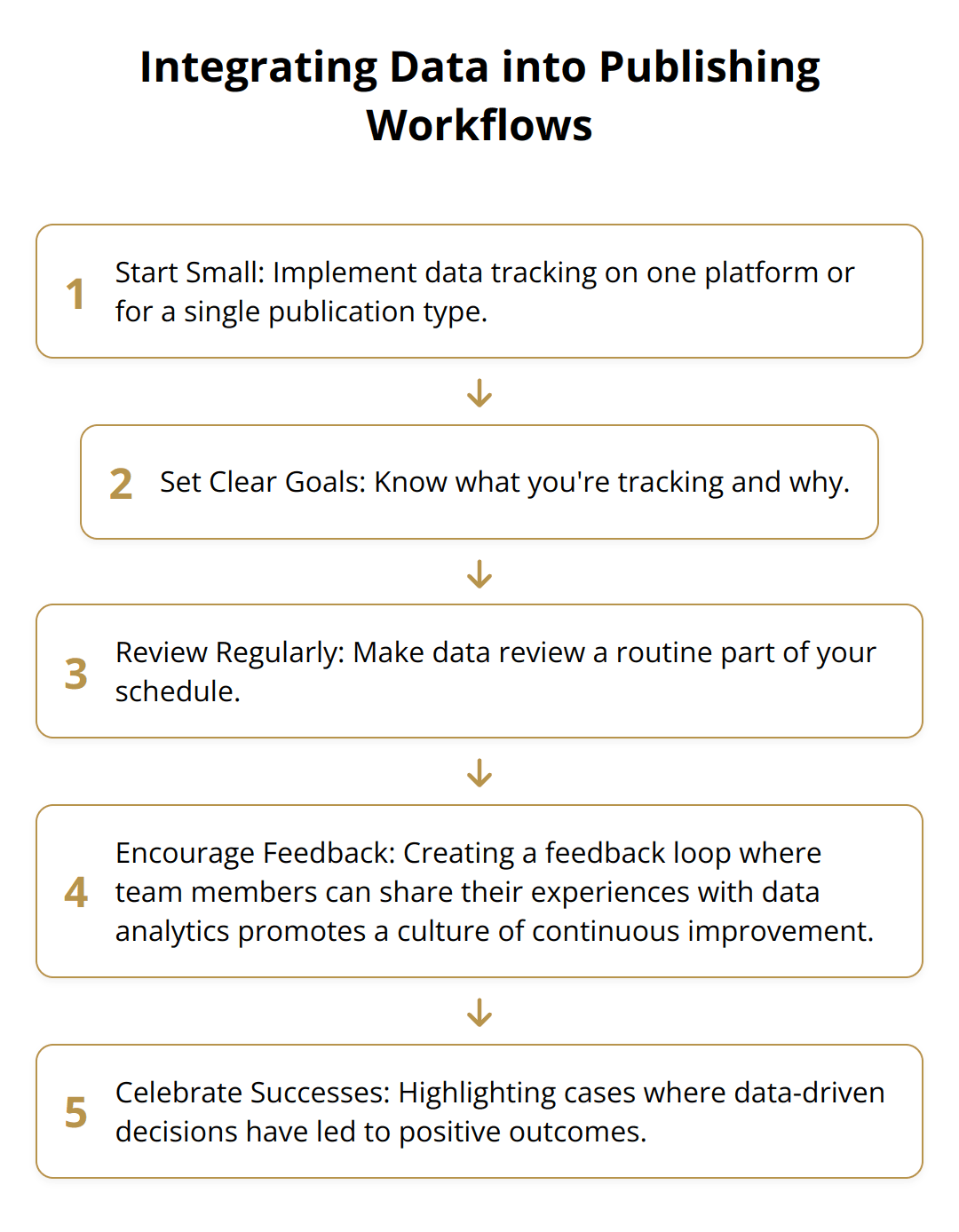Gone are the days when publishing relied solely on gut feeling. At Beverly Hills Publishing, we’ve witnessed the transformative power of data analytics in making well-informed decisions.
This shift has revolutionized the way content is tailored, targeted, and delivered, aligning perfectly with readers’ expectations and interests.
Shifting to Data-Driven Publishing
The evolution from relying on intuition to adopting data analytics for publishing decisions marks a significant milestone. This transition enables publishers to produce content that resonates more deeply with their audience, ensuring higher engagement rates and overall satisfaction. Let’s delve deeper into what this shift entails and how it revolutionizes content creation and distribution.
The New Era of Publishing Analytics
In the past, publishing decisions were often based on gut feelings or past experiences. However, the landscape has drastically changed. Today, data analytics provide a concrete foundation for making strategic decisions. The type of content to create, the best time to publish, and understanding what truly engages the audience are now questions answered with high certainty through data analysis.
Key Data Types for Publishers
For publishers, relevant data types encompass a wide range of metrics. Audience demographics, reading patterns, content engagement rates, and sales figures form the crux of essential data. Each metric offers insights that, when combined, create a comprehensive picture of the current market demands and future trends.
- Audience Demographics: Understanding who is reading helps tailor content to specific interests.
- Reading Patterns: Identifying when and how long people read can influence publication schedules.
- Engagement Rates: Engaging content is the key to reader retention. Analyzing what works helps refine future content.
- Sales Data: Sales figures offer a direct reflection of what readers are willing to pay for.
Leveraging Technology in Publishing
The adoption of sophisticated tools and technologies is central to harnessing the power of data analytics. Platforms like Google Analytics provide real-time insights into website traffic and content interaction, while social media analytics tools shed light on the content’s performance and audience engagement. For deeper analysis, AI and machine learning technologies offer predictive insights, helping publishers stay ahead of trends.
Furthermore, collaborating with platforms that specialize in publishing analytics can amplify your data-driven strategy. Integrations with tools such as Issuu or content management systems (CMS) equipped with analytic features enable publishers to track performance seamlessly across multiple channels.

Practical Insights for a Data-driven Approach
- Consistently Monitor Analytics: Regular review of your data helps identify trends and adjust strategies accordingly.
- Engage with Predictive Analytics: Utilize AI tools to forecast future trends and audience needs.
- Leverage Multi-channel Analytics: Understand your audience’s behavior across all platforms for a holistic view.
- Educate Your Team: Ensure your team understands the importance of data and how to interpret analytics effectively.

The shift to data-driven publishing is not just a trend but a fundamental change in how content is created, distributed, and monetized. By embracing data analytics, publishers can achieve greater alignment with their audience’s needs, leading to more successful outcomes.
By focusing on practical, actionable insights and leveraging the right tools, you’re not just keeping up with the industry—you’re setting new standards for success.
Why Data Drives Better Publishing
Data-driven decisions in publishing aren’t just about keeping up with trends; they’re about making strategic moves that directly impact your success. With the integration of data analytics, publishers can target their audience more accurately, enhance content engagement, and streamline decision-making processes. Let’s break down these benefits further.
Targeting Your Audience with Precision
Understanding your audience’s behavior and preferences allows for pinpointed content creation. This means not just knowing who your readers are but understanding what they want, when they want it, and how they prefer to consume it. Using data analytics, you can segment your audience based on various factors such as age, location, interests, and reading habits, ensuring that your content reaches the right people at the right time.

Boosting Content Performance
Enhanced reader engagement is a direct result of delivering targeted content. When you know what resonates with your audience, you can tailor your content strategy to include topics and formats that hold their interest. This not only increases the time readers spend with your content but also amplifies the chances of conversion, whether that’s selling a book, securing a subscription, or prompting an action. Data helps identify what works and what doesn’t, enabling a cycle of continuous improvement in content strategy.
Streamlining Decision-Making
Perhaps one of the most significant impacts of data analytics in publishing is the efficiency it brings to decision-making. No longer do publishing professionals need to make choices based on gut feelings; now, they have access to real-time data that can guide their decisions. This leads to more strategic planning, budget optimization, and resource allocation. Whether it’s determining the best publishing platform, the ideal marketing strategy, or the timing of your releases, data can provide insights that lead to more informed decisions.

Practical Tips for Implementing Data-Driven Strategies
- Utilize Analytics Tools: Platforms like Google Analytics offer invaluable insights into content performance and audience behavior.
- Focus on Key Metrics: Pay attention to engagement metrics such as time spent on page, bounce rate, and conversion rates to gauge content success.
- Test and Iterate: Use A/B testing to experiment with different content formats and strategies, using data to guide your decisions.
Publishers armed with data can adapt to changing reader preferences, market demands, and technology trends. This doesn’t just result in better content; it drives growth, enhances reader loyalty, and ultimately, increases revenue. The use of data in publishing is not an option—it’s a necessity for those aiming for long-term success.
Building a Data-Driven Culture
Embracing a data-driven approach in publishing necessitates a fundamental shift in mindset and operations. The path to integrating data analytics into publishing workflows lies in fostering a culture that values data at every level and selecting the right tools to empower your team. Here’s what it takes to make that leap.
Fostering a Culture that Values Data
Data-driven strategies thrive in an environment where every team member understands the importance of data. Training and education play key roles here, ensuring that everyone from editors to marketing professionals can interpret and apply data insights to their work. It’s about moving beyond seeing data as just numbers and recognizing it as a valuable asset for making informed decisions.
Selecting the Right Tools
The market is flooded with data analytics tools, each offering unique features. The key is to choose platforms that align with your publishing goals and workflow. Tools like Google Analytics for web traffic insights and social media analytics for engagement metrics are indispensable. However, the real game-changer could be AI and machine learning tools that predict trends and reader behavior, allowing you to stay one step ahead.
Integrating Data into Publishing Workflows
Here’s where theory meets application. Merging data analytics with day-to-day operations might seem daunting, but with a structured approach, it’s entirely achievable.

By adopting these practices, you pave the way for a more informed, responsive, and effective publishing process. A data-driven culture doesn’t emerge overnight, but with commitment and the right tools, the benefits—ranging from increased reader engagement to sharper market insights—are within reach.
Transitioning to a data-driven model is not just about leveraging technology but also reshaping organizational culture to prioritize informed decision-making. As publishers, steering through the rapidly evolving landscape with data as our compass, we’re not just following trends; we’re crafting stories that resonate, discovering new opportunities, and defining the future of publishing.
Final Thoughts
The landscape of publishing has undergone a dramatic transformation, shifting from intuition-based decisions to a data-driven approach that leverages analytics for strategic decision-making. At Beverly Hills Publishing, we’ve seen firsthand how data analytics empower publishers to deliver content that resonates with their audience, drives engagement, and ultimately, leads to higher satisfaction. The benefits of adopting a data-driven mindset in publishing are clear and compelling. It enables publishers to:

- Target audiences more accurately, ensuring content reaches those most likely to engage and respond positively.
- Enhance content performance by tailoring content strategies to meet the specific needs and preferences of readers.
- Streamline decision-making processes through access to actionable insights, making operations more efficient and effective.
Adopting data analytics in the publishing process isn’t an optional upgrade; it’s essential for publishers looking to succeed in a competitive and ever-changing market. It’s about making informed decisions that not only keep pace with industry trends but also set new benchmarks for success.
We at Beverly Hills Publishing understand the pivotal role data plays in crafting successful publishing strategies. Our innovative approach combines groundbreaking publishing with strategic branding and marketing to establish authors as leading authorities in their fields. By embracing data analytics, we ensure our authors not only achieve publication success but also enhance their personal and professional brands, emerging as industry leaders.
For publishers and authors alike, the path forward is clear. Embracing data analytics is not just a strategy for future success, it’s the cornerstone of creating impactful, resonant content in today’s dynamic publishing landscape. Let’s not shy away from leveraging the power of data to transform insights into action, crafting stories that captivate and engage, and elevating the publishing industry to new heights.















































































